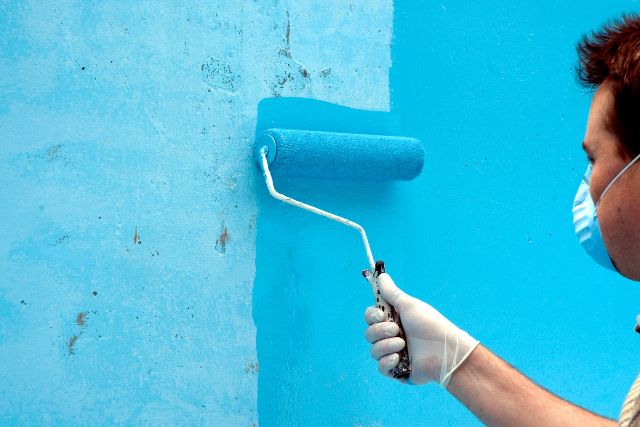When it comes to giving your home a fresh new look, painting is often at the top of the list.
Whether it’s a single-room refresh or an entire house transformation, the question of whether to tackle the job yourself or hire a professional painter is a common dilemma.
In this comprehensive guide, we’ll delve into the costs, pros and cons of both options to help you make an informed decision tailored to your situation and needs, with a particular focus on the Australian market.
Introduction
Painting is a popular home improvement project due to its relatively low cost and significant impact on a home’s appearance and value.
However, the decision between DIY painting and hiring a professional service requires careful consideration of various factors.
This introduction will set the stage for an in-depth analysis of both options.

Understanding the Scope of Painting Projects
The size and complexity of your painting project will greatly influence your decision.
Smaller, straightforward tasks may be more suited to DIY, while larger or more complex projects may necessitate a professional touch.
It’s essential to realistically assess your skills, available time, and the specific requirements of the job before making a decision.
The Dilemma: DIY vs. Hiring Professionals
DIY painting can offer cost savings and a sense of achievement, but it also comes with its own set of challenges and potential pitfalls.
On the other hand, professional painters bring expertise and efficiency, albeit at a higher upfront cost. This article will explore the pros and cons of each option in detail.
Importance of Making an Informed Decision
Making the right choice between DIY painting and hiring professionals will impact not only the quality of the finished job but also your overall satisfaction and the value added to your property.
It’s crucial to weigh the costs and benefits of each option carefully, considering your budget, timeline, and desired outcome.
Section 1: DIY Painting
Do-it-yourself painting is a popular choice for many homeowners looking to save money and take control of their home improvement projects.
In this section, we will explore the advantages and disadvantages of taking the DIY route.
Pros of DIY Painting
DIY painting has several appealing benefits, including potential cost savings, the satisfaction of completing a project on your own, and having complete control over every aspect of the job.
Cost Savings
One of the most significant advantages of DIY painting is the potential for cost savings. By taking on the job yourself, you can save on the labour costs associated with hiring professionals.
However, it’s important to consider the cost of materials and any tools you may need to purchase or rent.
Sense of Accomplishment
Completing a painting project on your own can provide a strong sense of accomplishment and pride in your work. It allows you to take direct control of the outcome and can be a rewarding experience.

Control Over Project
DIY painting gives you complete control over every aspect of the project, from the choice of paint and materials to the timeline and workflow.
This can be especially appealing if you have specific preferences or requirements for the job.
Cons of DIY Painting
While DIY painting has its advantages, it also comes with potential downsides, including the time investment required, the risk of mistakes, and the challenge of achieving a professional finish.
Time Consumption
Painting can be a time-consuming task, especially for those who are not experienced.
It’s important to consider whether you have the necessary time to dedicate to the project and whether the time investment is worth the potential cost savings.
Potential for Mistakes
Without professional training and experience, the risk of making mistakes increases. Common DIY painting mistakes include uneven application, drips, and failure to properly prepare surfaces.
These mistakes can lead to a less-than-desirable finish and may even require additional time and money to fix.
Lack of Professional Finish
Professional painters have the skills, tools, and experience to achieve a high-quality finish that may be challenging to replicate as a DIY painter.
If you’re aiming for a flawless finish, it’s important to consider whether DIY painting will meet your expectations.

Tools and Materials Needed for DIY Painting
Successful DIY painting requires the right tools and materials. This section provides an overview of the essential items you’ll need to complete a painting project on your own.
Paint and Primer
Choosing the right paint and primer is crucial to the success of your painting project.
It’s important to consider the surface you’re painting, the desired finish, and any specific requirements such as durability or weather resistance.
Don’t forget to calculate the total amount of paint required based on the size of the area you’re painting.
Brushes and Rollers
High-quality brushes and rollers can make a significant difference in the finish of your paint job.
Choose the appropriate size and type for your project, and ensure you have all the necessary accessories such as trays and extension poles.
Drop Cloths and Tape
Protecting your floors, furniture, and fixtures is essential when painting. Use drop cloths to cover large areas and painter’s tape to create clean edges and protect surfaces.
Cost Breakdown of DIY Painting
To help you make an informed decision, this section provides a detailed breakdown of the costs associated with DIY painting, including materials, tools, and the value of your time.
Material Costs
The cost of paint, brushes, rollers, and other materials can add up quickly. It’s important to shop around and compare prices to ensure you’re getting the best deal.
Remember to factor in any additional costs such as paint trays, drop cloths, and painter’s tape.
Time Investment
While DIY painting can save you money on labour costs, it’s important to consider the value of your time.
Consider how many hours the project will take and weigh this against the potential cost savings of doing the job yourself.
Section 2: Hiring a Professional Painting Service
Hiring a professional painting service can provide a hassle-free and high-quality solution to your painting needs. In this section, we’ll explore the benefits and potential drawbacks of going the professional route.
Pros of Professional Painting Services
Professional painters bring a level of expertise and efficiency to the table that can be hard to match as a DIY painter. Here we explore the advantages of hiring professionals.

High-Quality Finish
Professional painters have the skills, experience, and tools to achieve a flawless finish.
They understand the nuances of surface preparation, paint application, and finishing touches, ensuring a high-quality result.
Efficiency and Speed
With years of experience, professional painters can complete a painting project much faster than the average DIY painter.
This efficiency can be especially beneficial if you’re on a tight timeline or if the painting project is part of a larger renovation.
Expertise and Experience
Professional painters have encountered a wide range of painting scenarios and challenges, equipping them with the knowledge and expertise to handle any issues that may arise.
They can provide valuable advice on colour choices, finishes, and materials, ensuring the best possible outcome for your project.
Cons of Professional Painting Services
While there are many benefits to hiring professional painters, there are also potential drawbacks to consider. This section outlines the potential downsides of going the professional route.
Higher Upfront Costs
The most significant drawback of hiring professional painters is the higher upfront cost. Labour costs can significantly increase the total cost of your painting project, making it important to budget accordingly.
Less Personal Control
When you hire professionals, you relinquish a certain degree of control over the project.
While professional painters will work with you to understand your vision and preferences, the final execution is in their hands.
This can be a potential drawback for those who have specific preferences or enjoy being involved in every aspect of the project.
Factors Influencing the Cost of Professional Painting Services
The cost of hiring professional painters can vary widely depending on a range of factors. This section explores the key elements that influence the cost of professional painting services.

Size of the Area to be Painted
The size of the area you need painted is one of the most significant factors influencing cost. Larger areas will require more time, paint, and materials, resulting in higher costs.
Be sure to measure accurately and discuss the scope of the project with potential painters to get an accurate quote.
Type of Paint Used
The type of paint you choose can also impact the cost of professional painting services. High-quality or specialty paints tend to be more expensive, but they may offer better durability and finish.
Discuss your options with professional painters to find the best balance between cost and quality.
Complexity of the Job
Complex painting jobs that require additional prep work, special techniques, or access to hard-to-reach areas can increase the cost of professional painting services.
Ensure you provide a detailed description of the job to get an accurate quote and avoid any surprise costs.
How to Choose a Professional Painter in Australia
Finding the right professional painter is crucial to the success of your project. This section provides tips on how to choose a reputable and reliable painter in Australia.

Check Licenses and Insurance
In Australia, professional painters are required to be licensed and insured. Verify that any painter you consider hiring has the necessary licenses and insurance to protect both you and them during the project.
Look for Reviews and Testimonials
Reading reviews and testimonials from previous clients can provide valuable insight into a painter’s reliability, work ethic, and quality of work.
Look for reviews on independent websites or ask the painter for references.
Ask for Quotes and Compare
Get quotes from multiple painters to compare prices and services.
Ensure the quotes are detailed and include all aspects of the job, including preparation, materials, and cleanup. Use this information to make an informed decision based on value, not just price.
Section 3: Comparative Analysis
This section provides a comparative analysis of DIY painting versus hiring professional painting services, helping you understand when each option might be more feasible and providing real-life cost comparisons.
When is DIY Painting More Feasible?
DIY painting may be more feasible for smaller, less complex projects where the cost savings outweigh the time investment.
If you have previous painting experience and are confident in your ability to achieve a high-quality finish, DIY painting could be a viable option.

When is Hiring a Professional the Better Option?
Hiring a professional is often the better option for larger or more complex projects, when a high-quality finish is paramount, or when you’re on a tight timeline.
The expertise and efficiency of professional painters can provide peace of mind and a superior result.
Cost Comparison: Real-Life Scenarios
To provide a clearer picture, this section presents real-life cost comparisons between DIY painting and hiring professional services for various painting scenarios.
The examples take into account the size of the area, the complexity of the job, and the materials required, providing a comprehensive view of the potential costs and benefits of each option.
Section 4: Tips and Best Practices
Whether you decide to tackle your painting project on your own or hire professionals, this section provides valuable tips and best practices to ensure a successful outcome.
DIY Painting Tips
If you choose to go the DIY route, these tips will help you achieve the best possible result and avoid common pitfalls.
Preparation is Key
Proper preparation is crucial to a successful paint job. Take the time to clean, sand, and prime surfaces as necessary, and ensure your work area is well-organized and protected from paint splatters.
Invest in Quality Tools and Paint
Using high-quality tools and paint can significantly impact the finish of your paint job.
While it may be tempting to cut costs by choosing cheaper options, investing in quality materials will pay off in the long run.
Tips for Hiring and Working with Professional Painters
If you decide to hire professional painters, these tips will help ensure a smooth and successful partnership.
Clear Communication
Clear and open communication is key to a successful working relationship with professional painters.
Be sure to discuss your expectations, preferences, and any specific requirements upfront to avoid any misunderstandings.

Set Clear Expectations
Before work begins, ensure that you and the painting professionals are on the same page regarding the scope of the project, the timeline, and the expected outcome.
Having a written agreement or contract can help clarify expectations and provide a reference point for both parties.
Inspect the Work Regularly
Stay involved in the project by inspecting the work regularly. This allows you to address any concerns or issues promptly, ensuring that the final result meets your expectations.
Conclusion
Choosing between DIY painting and hiring professional painters is a significant decision that depends on various factors, including the size and complexity of the project, your budget, timeline, and personal preferences.
Both options have their pros and cons, and the best choice will depend on your specific situation.
DIY painting can offer cost savings and a sense of personal accomplishment, but it requires a significant time investment and carries the risk of mistakes.
On the other hand, professional painters provide expertise, efficiency, and a high-quality finish, albeit at a higher upfront cost.
By carefully considering the factors outlined in this guide, weighing the costs and benefits of each option, and following the tips and best practices provided, you can make an informed decision that leads to a successful and satisfying painting project.




